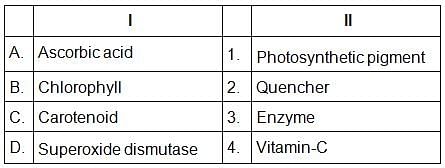SSC CGL Previous Year Questions: General Science - 6 - SSC CGL MCQ
30 Questions MCQ Test - SSC CGL Previous Year Questions: General Science - 6
Viruses that infect bacteria are called (SSC Sub. Ins. 2016)
A dispersion indicates (SSC Sub. Ins. 2016)
| 1 Crore+ students have signed up on EduRev. Have you? Download the App |
The principle involved in the absorption of water by soil is (SSC Sub. Ins. 2016)
Which of the following is present in maximum amount in acid rain? (SSC Sub. Ins. 2016)
The lethal dose required to kill 50% of the lab animals tested under standard is referred as (SSC Sub. Ins. 2016)
Electric current is measured using which of the following instrument ? (SSC CGL 1st Sit. 2015)
Photoperiodism affects (SSC CGL 1st Sit. 2015)
Match the following : (SSC CGL 1st Sit. 2015)

Allantois of Embryo helps in (SSC CGL 1st Sit. 2015)
Which one of the following animals belongs to mollusca ? (SSC CGL 1st Sit. 2015)
Outside the nucleus DNA is found in (SSC CGL 1st Sit. 2015)
Animal protein is called first class protein because it is (SSC CGL 1st Sit. 2015)
It is easy to burst a gas filled balloon with a needle than with a nail. It is because (SSC CGL 1st Sit. 2015)
The velocity of sound in moist air is more than in dry air because the moist air has (SSC CGL 1st Sit. 2015)
X–rays can be used (SSC CGL 1st Sit. 2015)
Ice is packed in saw dust because (SSC CGL 1st Sit. 2015)
What happens when a drop of glycerol is added to crushed KMnO4 spread of a paper ? (SSC CGL 1st Sit. 2015)
Most commonly used bleaching agent is (SSC CGL 1st Sit. 2015)
The least penetrating power ray is (SSC CGL 1st Sit. 2015)
Hydrogen peroxide is an effective sterilizing agent. Which one of the following product results when it readily loses active oxygen ? (SSC CGL 1st Sit. 2015)
The maximum fixation of solar energy is done by (SSC CGL 1st Sit. 2015)
The term 'brown air' is used for (SSC CGL 1st Sit. 2015)
Peroxyacetyl nitrate is a (SSC CGL 1st Sit. 2015)
Which of the following particles has the dual nature of particle–wave ? (SSC CGL 1st Sit. 2015)
The metal ion present in vitamin B12 is (SSC CGL 1st Sit. 2015)
Who of the following has given the term rhizosphere (SSC CGL 1st Sit. 2015)
Reverse transcription was discovered by (SSC CGL 1st Sit. 2015)
Burns caused by steam are much more severe than those caused by boiling water because: (SSC CGL 1st Sit. 2015)
Which among the following is the sweetest sugar? (SSC CGL 1st Sit. 2015)
Ultra purification of a metal is done by : (SSC CGL 1st Sit. 2015)

















